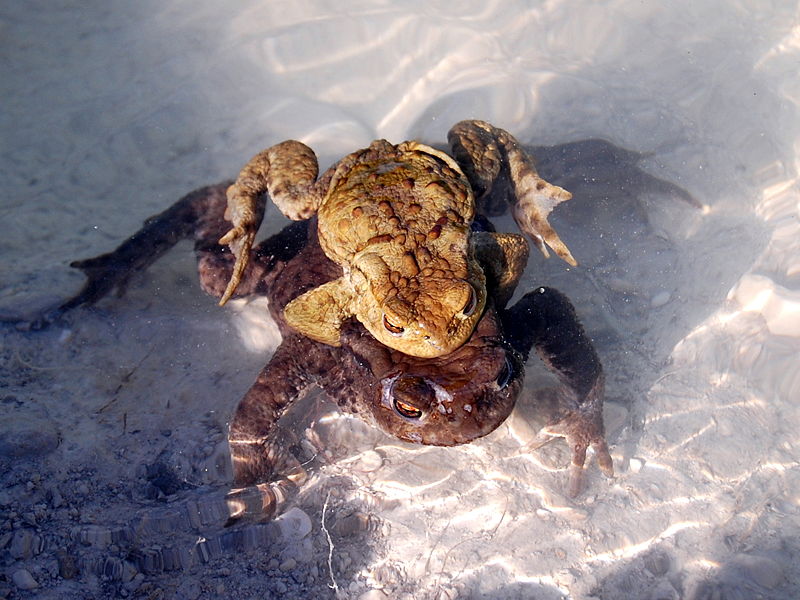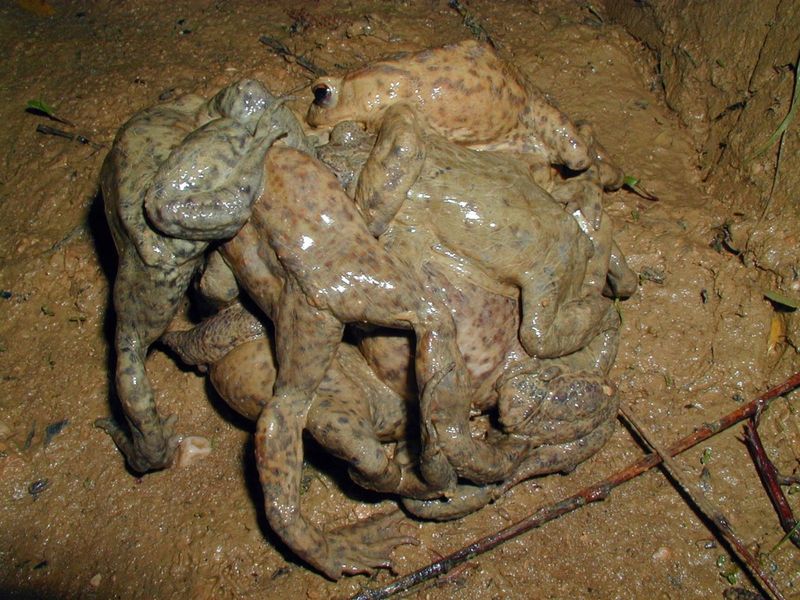The Most-Traveled Cane Toad
Rated "R" Lovin' -- aka, Breeding Habits
There's LOTS of info on this page. Each of the following is addressed (and bookmarked) on this page. I recommend just reading on down the page!
Sub-topics of the page:
Breeding season and habits.Is there an "emergency release" communication?

Seasons? Cane toads can enjoy breeding year round, depending on their habitat. In the tropics, they feel compelled to breed year round, while in the cooler subtropics they confine their breeding activities to the warm season. Like almost all Anurans (frogs and toads), cane toads deposit eggs in a pool of water. Toads tend to select locations that would make decent nurseries for their young. Breeding locations depend on whether the watering hole is permanent or temporary, the density of vegetation (which serves as potential food for tadpoles), and water conditions such as clarity, pH, and temperature. Slow-moving, warm, permanent freshwater settings are ideal, but even brackish waters will do. Interestingly, the toads don’t seem to consider the density of fish population; their ignorance of potential predators only makes sense in their non-native environments where predators are scarce, but this trend holds even in locations where the toads are indigenous.
 Males gather
at the water and call
for females. His trills
last about 30 seconds and sound like
a faint tractor. As the number of males
increases, the sound can become very loud.
Females either hear the males through their ears, or feel the
ground vibrations through their body; the vibrations help direct them to the males, much like a GPS tells
directionally-challenged humans where to go.
The female approaches her selected male.
Males gather
at the water and call
for females. His trills
last about 30 seconds and sound like
a faint tractor. As the number of males
increases, the sound can become very loud.
Females either hear the males through their ears, or feel the
ground vibrations through their body; the vibrations help direct them to the males, much like a GPS tells
directionally-challenged humans where to go.
The female approaches her selected male.
 He
mounts her, wrapping his forearms around her ribcage just
behind her own forearms. This is only
appears romantic ; in reality he is using thumb
calluses called nuptial pads to securely latch his thumbs under
her ribcage in a no-escape hold. Although
different Anurans may
amplex differently (utilizing one alternate
grasp), nuptial pads are common to males
of many species. In some species
the pads are thought to not only facilitate his stronghold on
the female, but also to release substances which encourage her
body to lay the eggs. Whether the nuptial
pads in cane toads have this female-stimulatory feature is
unknown.
He
mounts her, wrapping his forearms around her ribcage just
behind her own forearms. This is only
appears romantic ; in reality he is using thumb
calluses called nuptial pads to securely latch his thumbs under
her ribcage in a no-escape hold. Although
different Anurans may
amplex differently (utilizing one alternate
grasp), nuptial pads are common to males
of many species. In some species
the pads are thought to not only facilitate his stronghold on
the female, but also to release substances which encourage her
body to lay the eggs. Whether the nuptial
pads in cane toads have this female-stimulatory feature is
unknown.

The sexual grasp may last anywhere from a few hours to the duration of an entire night’s tryst. With this male, the female lays all of her eggs – all 8,000 to 35,000 of them, depending upon the size and age of the female! All those eggs are laid in 1-2 strands of black eggs, which are often tethered to a rock or log. Fertilization occurs externally. To find out what happens from egg to adult, read lifecycle.
Sinking females? You might be wondering how the female
doesn’t sink when she has a male sitting on her,
especially since he won’t
give up on sex to save his life. Luckily, the
female can use her lungs as a floatation device – she can alter
her body density and make herself more buoyant simply by holding
more air in her lungs. This is very analogous
to the swim bladder in fish, and indeed cane toad lungs arise
from the tadpo le swim bladder.
le swim bladder.
And yes, the male will not let go for any reason. A mating pair will not disrupt the festivities even when approached and picked up by humans! And if there isn’t a viable female to be found, the male will “make do” and attempt amplexus with fish, humps of mud, and even human hands and feet. In the absence of females, a pile of males may be found, all in amplexus with each other. They'll even mate with pop cans. Poor guys!
But please
don’t underestimate the sexual drive of the male cane toad – he
has been known to hop onto a fairly busy road and begin amplexus
with a female who is smooshed to the pavement.
Ever devoted to his love --and let’s give the males credit
for the phrase “love is blind”
since she may be flat as a pancake
with her guts
erupting from her face-- the male has been known to remain
in amplexus even as the day reaches its peak of heat and sun
intensity, and to remain with his female despite oncoming
traffic. Hence he will face non-romantic
locations (scratchy pavement), a less than becoming mate, and
risk dehydration, predation, and cars, all to accomplish his
grand mission.
You might wonder, will the male release the object of his
affection for any reason? Maybe, sorta,
sometimes. Both males and females can
actually perform a “release signal”.
The release signal is a body vibration.
Males who find themselves inappropriately grasped combine
the body vibration with a vocalization. Males
who receive the “release signal” tend to release the acc idental
male partners but are less likely to release a female who is
simply unfriendly to his mission. Because
only males can vocalize for release, an amplexing male
definitely knows whether his unhappy partner is male or female.
Still, the female may vibrate --even though the male is
unlikely to respect her request – because of the tiny chance
that a nearby male in the pond will be calling at the same time
that she is vibrating, and hence potentially deceive her partner
into thinking that she is a he.
idental
male partners but are less likely to release a female who is
simply unfriendly to his mission. Because
only males can vocalize for release, an amplexing male
definitely knows whether his unhappy partner is male or female.
Still, the female may vibrate --even though the male is
unlikely to respect her request – because of the tiny chance
that a nearby male in the pond will be calling at the same time
that she is vibrating, and hence potentially deceive her partner
into thinking that she is a he.
In case you are wondering, in theory both sexes benefit from a release call/signal. A male will have wasted his efforts if he is attempting to male with another male, as no offspring will result. A female might use the release signal in order to be selective on her choice of partners. She might also use the signal if she is being unduly harassed by multiple males, if she has no more eggs to give (remember, she expends her entire clutch of eggs with one male); thus she would avoid a time-consuming act that wouldn’t result in fit offspring (likely to survive), or any offspring at all.
Now that you've learned about the act (and we're past the porn), learn about the fruits of all that effort! Go to lifecycle.